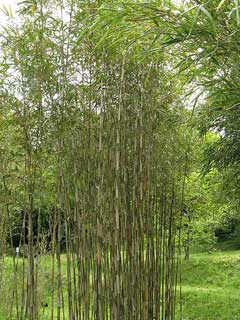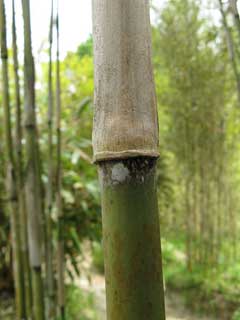 |
|
http://commons.wikimedia.org/wiki/User:KENPEI |
 |
| http://commons.wikimedia.org/wiki/User:KENPEI |
Translate this page:
Summary
Physical Characteristics

 Pleioblastus simonii is an evergreen Bamboo growing to 4.5 m (14ft 9in) at a fast rate.
Pleioblastus simonii is an evergreen Bamboo growing to 4.5 m (14ft 9in) at a fast rate.
See above for USDA hardiness. It is hardy to UK zone 6. It is in leaf all year. The species is hermaphrodite (has both male and female organs) and is pollinated by Wind.
Suitable for: light (sandy), medium (loamy) and heavy (clay) soils. Suitable pH: mildly acid, neutral and basic (mildly alkaline) soils. It can grow in semi-shade (light woodland) or no shade. It prefers moist soil. The plant can tolerate maritime exposure.
UK Hardiness Map
US Hardiness Map
Synonyms
Arundinaria simonii. Bambusa simonii. B. viridistriata. Nipponocalamus simonii.
Plant Habitats
Woodland Garden Sunny Edge; Dappled Shade; Hedge;
Edible Uses
Edible Parts: Seed Shoots Stem
Edible Uses:
Young shoots - cooked[25, 61, 105]. They have a very bitter flavour, this bitterness is considerably reduced by changing the water at least once during the cooking process - though this will also remove quite a few of the nutrients[K]. The new shoots are about 20mm in diameter[K]. Seed cooked. As a grass seed the paper husk must be removed before eating.
References More on Edible Uses
Medicinal Uses
Plants For A Future can not take any responsibility for any adverse effects from the use of plants. Always seek advice from a professional before using a plant medicinally.
None known
References More on Medicinal Uses
The Bookshop: Edible Plant Books
Our Latest books on Perennial Plants For Food Forests and Permaculture Gardens in paperback or digital formats.

Edible Tropical Plants
Food Forest Plants for Hotter Conditions: 250+ Plants For Tropical Food Forests & Permaculture Gardens.
More

Edible Temperate Plants
Plants for Your Food Forest: 500 Plants for Temperate Food Forests & Permaculture Gardens.
More

More Books
PFAF have eight books available in paperback and digital formats. Browse the shop for more information.
Shop Now
Other Uses
Hedge Hedge Plant support Wood
Canes are thin walled but extremely strong, they can be used as plant supports, also for fencing etc[25, 61, 74, 195]. Often used in China for making fan handles, poles and in various handicrafts[195]. Tolerant of maritime exposure and very hardy and vigorous, this plant makes a good screen or hedge[25, 166, 195].
Special Uses
Food Forest Hedge Hedge
References More on Other Uses
Cultivation details
A very easily grown bamboo, it succeeds in most soils but prefers a good loamy soil in sun or semi-shade[1]. Dislikes drought[1]. Tolerates maritime exposure[166]. A very hardy plant, it can tolerate temperatures down to between -20 and -25°c. The rootstock is running and very invasive[11, 25, 166]. Another report says that it is a vigorous grower but not invasive[195]. New shoots are produced from May[25]. The canes are harvested commercially for their many uses in Japan[195]. It is the third most commonly cultivated species in Japan[195]. This species is notably resistant to honey fungus[200]. Unlike many bamboos, this plant quite often flowers and sets viable seed, the plants do not usually die as a result of this[122]. However, if they are fed with artificial NPK fertilizers at this time they are far less likely to survive[122].
References Carbon Farming Information and Carbon Sequestration Information
Temperature Converter
Type a value in the Celsius field to convert the value to Fahrenheit:
Fahrenheit:
The PFAF Bookshop
Plants For A Future have a number of books available in paperback and digital form. Book titles include Edible Plants, Edible Perennials, Edible Trees,Edible Shrubs, Woodland Gardening, and Temperate Food Forest Plants. Our new book is Food Forest Plants For Hotter Conditions (Tropical and Sub-Tropical).
Shop Now
Plant Propagation
Seed - if possible, surface sow the seed as soon as it is ripe in a greenhouse at about 20°c. Stored seed should be sown as soon as it is received. Do not allow the compost to dry out. Germination usually takes place fairly quickly so long as the seed is of good quality, though it can take 3 - 6 months. Prick out the seedlings into individual pots when they are large enough to handle and grow them on in a lightly shaded place in the greenhouse or cold frame until they are large enough to plant out, which could be a number of years. The plants only flower at intervals of several years and so seed is rarely available. Division in spring as new growth commences. Very easy, single canes can be used. Pot them up in light shade in a greenhouse. Make sure the foliage is not allowed to dry out - misting 2 - 3 times a day for the first couple of weeks following divsion can be very helpful. Plant out in the summer once they are growing away strongly.
Other Names
If available other names are mentioned here
Native Range
TEMPERATE ASIA: Japan (Honshu (west), Kyushu, Shikoku)
Weed Potential
Right plant wrong place. We are currently updating this section.
Please note that a plant may be invasive in one area but may not in your area so it's worth checking.
Conservation Status
IUCN Red List of Threatened Plants Status :

Growth: S = slow M = medium F = fast. Soil: L = light (sandy) M = medium H = heavy (clay). pH: A = acid N = neutral B = basic (alkaline). Shade: F = full shade S = semi-shade N = no shade. Moisture: D = dry M = Moist We = wet Wa = water.
Now available:
Food Forest Plants for Mediterranean Conditions
350+ Perennial Plants For Mediterranean and Drier Food Forests and Permaculture Gardens.
[Paperback and eBook]
This is the third in Plants For A Future's series of plant guides for food forests tailored to
specific climate zones. Following volumes on temperate and tropical ecosystems, this book focuses
on species suited to Mediterranean conditions—regions with hot, dry summers and cool, wet winters,
often facing the added challenge of climate change.
Read More
Expert comment
Author
(Carrière.)Nakai.
Botanical References
1158200
Links / References
For a list of references used on this page please go here
Readers comment
| Add a comment |
|
If you have important information about this plant that may help other users please add a comment or link below. Only comments or links that are felt to be directly relevant to a plant will be included. If you think a comment/link or information contained on this page is inaccurate or misleading we would welcome your feedback at [email protected]. If you have questions about a plant please use the Forum on this website as we do not have the resources to answer questions ourselves.
* Please note: the comments by website users are not necessarily those held by PFAF and may give misleading or inaccurate information.
To leave a comment please Register or login here All comments need to be approved so will not appear immediately.
|
Subject : Pleioblastus simonii
|
|
|
|